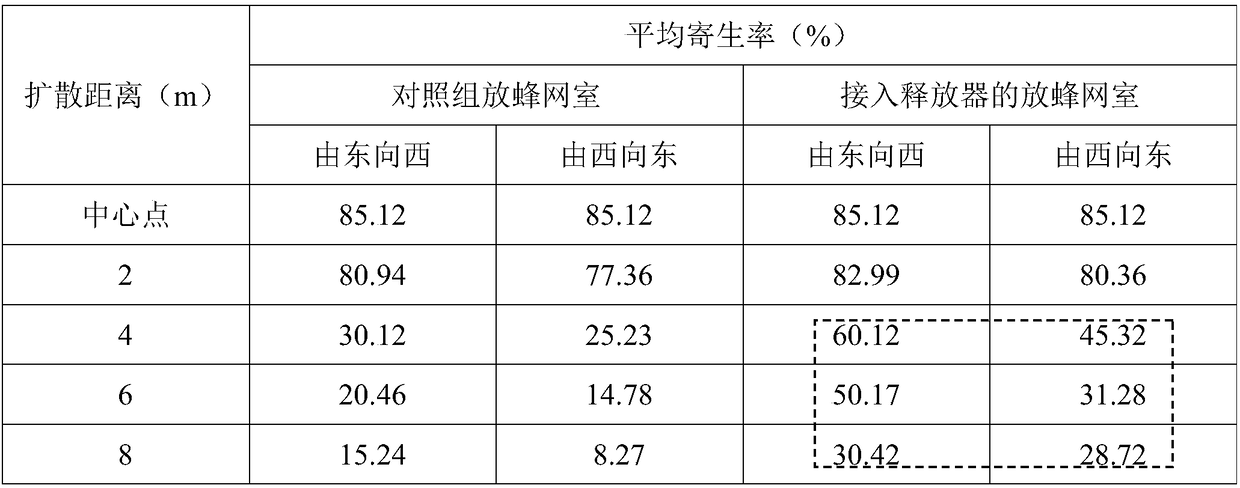Botanical attractant of encarsia formosa and application of botanical attractant
A technology of amphid wasps and attractants, applied in the direction of attracting pests, plant growth regulators, applications, etc., can solve the problems of insufficient diffusion ability and low parasitism rate of amphids, and improve the effect of biological control, The effect of simple preparation method and convenient use
- Summary
- Abstract
- Description
- Claims
- Application Information
AI Technical Summary
Problems solved by technology
Method used
Image
Examples
Embodiment 1
[0014] 1) Mix E)-β-ocimene, β-myrcene, methyl salicylate, and β-caryophyllene in a mass ratio of 1:1:1:1
[0015] 2) Mix the mixed components in 1) with paraffin oil in a weight ratio of 1:1 to obtain an attractant solution.
[0016] 3) The attractant solution obtained in 2) is added dropwise to the bait core to form a releaser with a slow release effect, and the amount of the attractant solution on each bait core is 1 gram.
Embodiment 2
[0018] 1) Mix E)-β-ocirene, β-myrcene, methyl salicylate, and β-caryophyllene in a mass ratio of 4:3:2:1
[0019] 2) Mix the mixed components of 1) with paraffin oil in a ratio of 10:1 by weight to obtain an attractant solution.
[0020] 3) Drop the attractant solution obtained in 2) onto the bait core to form a releaser with slow release effect, and the dripping amount of the attractant solution on each bait core is 8 grams.
[0021] Example 2:
[0022] The plant-derived attractant of Aphididae prepared in Example 1 was tested in the glass greenhouse of China Jiliang University.
[0023] 1) Establish two net rooms with a length of 10m, a width of 8m, and a height of 1.8m in the glass greenhouse, and cover the 60-mesh insect-proof nets, and transplant tomato seedlings into the two nets.
[0024] 2) After the tomato seedlings were transplanted, the Bemisia tabaci was inserted into six nets for indoor reproduction. After the Bemisia tabaci proliferated in large numbers for 20 days, three ...
Embodiment 3
[0032] 1) Establish two net rooms with a length of 10m, a width of 8m, and a height of 1.8m in the glass greenhouse, and a 60-mesh insect-proof net for transplanting tomato seedlings into the two nets.
[0033] 2) After the tomato seedlings are transplanted, the Bemisia tabaci is inserted into the two net rooms for indoor reproduction. After the Bemisia tabaci proliferates in large numbers, two net rooms are hung with the Aphid bee card for prevention and control. One net room is hung with the Aphid bee card and connected to the release prepared in Example 1, and the other is only hung As a control, the card was not connected to the release device.
[0034] 3) Set the bee release point in the middle of the net room, with the bee release point as the center, mark at 2, 4, 6, 8 meters away from the center point in the east-west direction. After placing the queen bee for 3 days, collect the leaves, observe the parasitic rate, and analyze The relationship between diffusion distance an...
PUM
 Login to View More
Login to View More Abstract
Description
Claims
Application Information
 Login to View More
Login to View More - R&D
- Intellectual Property
- Life Sciences
- Materials
- Tech Scout
- Unparalleled Data Quality
- Higher Quality Content
- 60% Fewer Hallucinations
Browse by: Latest US Patents, China's latest patents, Technical Efficacy Thesaurus, Application Domain, Technology Topic, Popular Technical Reports.
© 2025 PatSnap. All rights reserved.Legal|Privacy policy|Modern Slavery Act Transparency Statement|Sitemap|About US| Contact US: help@patsnap.com


